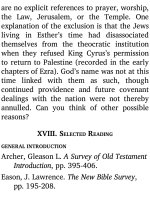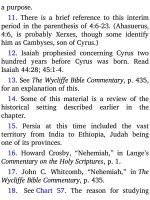Jensens survey of the old testament adam 616
Bạn đang xem bản rút gọn của tài liệu. Xem và tải ngay bản đầy đủ của tài liệu tại đây (117.25 KB, 4 trang )
hope of justice that must ultimately triumph
at the enthronement of Jesus Christ as King
of kings and Lord of lords. Christians living
in John’s day, under the growing threat of
imprisonment, and even death, by Emperor
Domitian, found comforting refuge in the
message of Revelation, even as have
persecuted Christians of all the ages since
then.
The book of Revelation also warns
Christians
against
the
treacherous
swamplands of apostasy, and it appeals for a
faithful allegiance to Christ. The letters of
chapters 2 and 3 especially emphasize such
warnings and appeals.
Revelation does not aim to give all the
prophetic details of the end times. Nor is the
program of church history spelled out.
Enough details are recorded to (1) describe
the crucial events (such as the great white
throne judgment, 20:11-15); (2) portray the
large movements and trends of world
history; and (3) teach spiritual principles
underlying God’s sovereign plan.
G. APOCALYPTIC WRITING
Revelation is prophetic in character and
apocalyptic in form.5 Here are some of its
major features as apocalyptic literature:6
1. mainly eschatological (eschatos: last
times)
2. written during times of persecution
3. visions abound
4. style generally gurative, with an
abundance of symbols.
H. SYMBOLISM OF REVELATION
As noted earlier, Revelation is lled with
symbols, such as numbers, colors, animals,
stones, persons, groups, places, and actions.
Three categories of symbols appear in the
book: (1) those interpreted in the text itself
(e.g., 1:20); (2) those to be interpreted in
the light of Old Testament usage; (3)
symbols of no apparent biblical connection.
(See Further Study.)
I. SCHOOLS OF INTERPRETATION
Basically, there are four di erent schools
of interpretation of the book of Revelation.
These are shown on Chart 121. Observe on
the chart where each view places each of
the twenty-two chapters of Revelation. This
is one of the best ways to see the major
di erences between the schools. Observe the
following descriptions of the different views.
1.
The
symbolic
view
interprets
Revelation as only a series of pictures
teaching spiritual truths. It sees no prophecy
of speci c historical events in Revelation.
The rst and last chapters of the book are a
clear argument against such a static view.
2. The preterist view sees all of Revelation
historically ful lled in the rst century, with
eternal destinies taught in the last two
chapters. This view su ers much of the
anemia of the symbolic view.
3. The continuous-historical view applies
Revelation prophetically to all the centuries
since the time of Christ. Only chapters 19-22
foretell events after Christ’s second coming.
Proponents of this view di er widely in
identifying historical events prophesied in
chapters 4-18. Some typical interpretations
are shown on the chart (e.g., the mighty
angel of chap. 10 is the Reformation).









